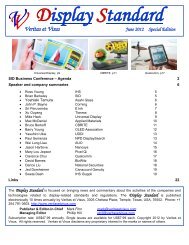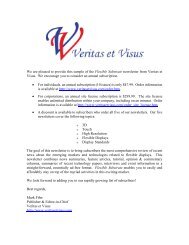You also want an ePaper? Increase the reach of your titles
YUMPU automatically turns print PDFs into web optimized ePapers that Google loves.
<strong>Veritas</strong> <strong>et</strong> <strong>Visus</strong> <strong>Display</strong> <strong>Standard</strong> February 2009<br />
Viewing angle and spectral characterization<br />
of LCDs and their components<br />
Pierre Boher earned an Engineer Degree at the ECP (Ecole Centrale des Arts <strong>et</strong> Manufactures)<br />
in 1982. After earning his Ph.D. in material sciences in 1984, he worked in the French Philips<br />
Laboratories during nine years on the deposition and characterization of very thin films and<br />
multilayers. R&D manager at SOPRA b<strong>et</strong>ween 1995 and 2002, he was involved in the<br />
development of different m<strong>et</strong>rology tools for non-destructive characterization mainly for<br />
microelectronics. He joined Eldim in 2003 to work in the research and development of new<br />
m<strong>et</strong>rology heads. This article was co-authored by T. Leroux, T. Bignon, and D. Glinel, all from<br />
Eldim. http://www.eldim.fr<br />
57<br />
by Pierre Boher<br />
A new Fourier optics system capable of measuring spectral information at each incidence<br />
and azimuth angles is presented. In reasonable measurement times, a full viewing angle<br />
pattern of radiance at 31 wavelengths regularly distributed in the visible range is obtained. Full polarization analysis<br />
of the light at each wavelength is possible. Paper focuses on gray level and polarization analyses of one LCD<br />
display in order to show some of the possibilities of the new instrument.<br />
Fourier optics based systems are now widely used for color and luminance viewing angle measurements of many<br />
types of displays and components. The measurement speed and the large amount of data are key param<strong>et</strong>ers to<br />
estimate viewing angle properties rapidly and accurately. Nevertheless, standard color measurements, even if<br />
perfectly adjusted to the human eye sensitive, are quite restrictive compared to the complex spectral stimuli always<br />
emitted by any kind of display. A multispectral analysis with 20 to 30 channels in the visible range can be helpful.<br />
For digital color imaging and color reproduction this approach has been used with success. 1,2 Some attempts have<br />
been made recently to characterize backlights with hyper-spectral camera. 3 Transmission of display components<br />
such as polarizer and diffusion films, can exhibit complex spectral behaviors that need to be taken into account for<br />
precise predictions of the emissive properties. Recently a new generation of viewing angle systems EZContrastMS<br />
from ELDIM capable of providing multispectral information on the full cone of view of displays in reasonable<br />
measurement times has been presented. 4 This system can provide radiance information but also compl<strong>et</strong>e<br />
polarization analysis versus wavelength. We focus on this aspect in the present paper.<br />
Experimental d<strong>et</strong>ails: The new system is based on the well known Fourier transform EZContrast viewing angle<br />
instruments proposed by ELDIM for more than ten years. Compared to standard instrument the five color filters are<br />
replaced by 31 band pass filters regularly distributed in the visible range. The system makes automatically a quasispectral<br />
image of the full Fourier plane at each filter and the sequence is repeated for all the filters. The system is<br />
calibrated in an absolute way to reconstruct the spectral radiance at each incidence and azimuth angle.<br />
Compl<strong>et</strong>e measurement sequence takes less than three minutes for a 100cd/m 2 white source. Color and luminance<br />
properties can be recalculated with an excellent accuracy. The system includes also different polarizers and<br />
waveplates in the same way as standard systems, 5 to allow full polarization analysis at each filter wavelength.<br />
Polarization ellipticity, polarization direction and polarization degree are then available in the full viewing angle for<br />
each wavelength.<br />
Experimental results: In this article, we have decided to measure the same LCD display in three different<br />
conditions to show the new possibilities of the instrument: a first s<strong>et</strong> of radiance measurements is made on ON state<br />
and OFF state. Then gray level analysis is made. Finally polarization dependence without top polarizer is measured.






